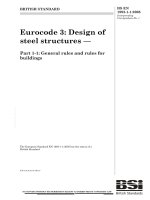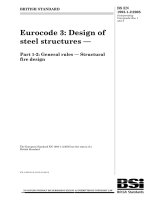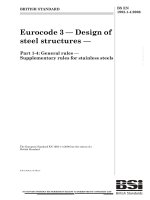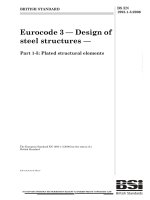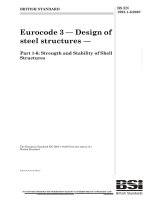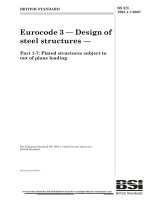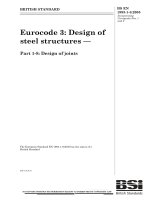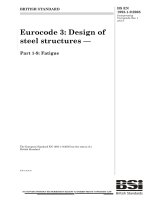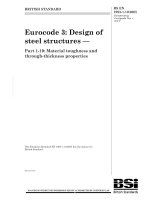Tiêu chuẩn Châu Âu EC7: Kết cấu nền móng phần 1.1: Quy định chung (Eurocode7 BS EN1997 1 e 2004 Geotechnicl desgn part 1.1: General rules)
Bạn đang xem bản rút gọn của tài liệu. Xem và tải ngay bản đầy đủ của tài liệu tại đây (1.8 MB, 172 trang )
BRITISH STANDARD
Eurocode 7:
Geotechnical design —
Part 1: General rules
The European Standard EN 1997-1:2004 has the status of a
British Standard
ICS 91.120.20
12 &23<,1* :,7+287 %6, 3(50,66,21 (;&(37 $6 3(50,77(' %< &23<5,*+7 /$:
BS EN
1997-1:2004
BS EN 1997-1:2004
National foreword
This British Standard is the official English language version of
EN 1997-1:2004. It supersedes DD ENV 1997-1:1995 which is withdrawn.
The structural Eurocodes are divided into packages by grouping Eurocodes for
each of the main materials, concrete, steel, composite concrete and steel,
timber, masonry and aluminium, this is to enable a common date of
withdrawal (DOW) for all the relevant parts that are needed for a particular
design. The conflicting national standards will be withdrawn at the end of the
coexistence period.
Following publication of the EN, there is a period of 2 years allowed for the
national calibration period during which the National annex is issued, followed
by a three year coexistence period. During the coexistence period Member
States will be encouraged to adapt their national provisions to withdraw
conflicting national rules before the end of the coexistent period. The
Commission in consultation with Member States is expected to agree the end
of the coexistence period for each package of Eurocodes.
At the end of this coexistence period, the national standard(s) will be
withdrawn.
In the UK, the corresponding national standards are:
— BS 6031:1981, Code of practice for earthworks;
— BS 8004:1986, Code of practice for foundations;
— BS 8081:1989, Code of practice for ground anchorages;
— BS 8002:1994, Code of practice for earth retaining structures;
— BS 8006:1995, Code of practice for strengthened/reinforced soils and
other fills;
— BS 8008:1996, Safety precautions and procedures for the construction
and descent of machine-bored shafts for piling and other purposes;
— BS 5930:1999, Code of practice for site investigations;
and based on this transition period, these standards will be withdrawn on a
date to be announced.
The UK participation in its preparation was entrusted to Technical Committee
B/526, Geotechnics, which has the responsibility to:
This British Standard, was
published under the authority
of the Standards Policy and
Strategy Committee
on 22 December 2004
—
aid enquirers to understand the text;
—
present to the responsible international/European committee any
enquiries on the interpretation, or proposals for change, and keep the
UK interests informed;
—
monitor related international and European developments and
promulgate them in the UK.
Amendments issued since publication
Amd. No.
© BSI 22 December 2004
ISBN 0 580 45212 3
Date
Comments
BS EN 1997-1:2004
A list of organizations represented on this committee can be obtained on request
to its secretary.
Where a normative part of this EN allows for a choice to be made at the national
level, the range and possible choice will be given in the normative text, and a note
will qualify it as a Nationally Determined Parameter (NDP). NDPs can be a
specific value for a factor, a specific level or class, a particular method or a
particular application rule if several are proposed in the EN.
To enable EN 1997-1 to be used in the UK, the NDPs will be published in a
National annex, which will be made available by BSI in due course, after public
consultation has taken place.
Cross-references
The British Standards which implement international or European publications
referred to in this document may be found in the BSI Catalogue under the section
entitled “International Standards Correspondence Index”, or by using the
“Search” facility of the BSI Electronic Catalogue or of British Standards Online.
This publication does not purport to include all the necessary provisions of a
contract. Users are responsible for its correct application.
Compliance with a British Standard does not of itself confer immunity
from legal obligations.
Summary of pages
This document comprises a front cover, an inside front cover, page i and ii, the
EN title page, pages 2 to 167 and a back cover.
The BSI copyright notice displayed in this document indicates when the
document was last issued.
i
ii
blank
EN 1997-1
EUROPEAN STANDARD
NORME EUROPÉENNE
EUROPÄISCHE NORM
November 2004
ICS 91.120.20
Supersedes ENV 1997-1:1994
English version
Eurocode 7: Geotechnical design - Part 1: General rules
Eurocode 7: Calcul géotechnique - Partie 1: Règles
générales
Eurocode 7: Entwurf, Berechnung und Bemessung in der
Geotechnik - Teil 1: Allgemeine Regeln
This European Standard was approved by CEN on 23 April 2004.
CEN members are bound to comply with the CEN/CENELEC Internal Regulations which stipulate the conditions for giving this European
Standard the status of a national standard without any alteration. Up-to-date lists and bibliographical references concerning such national
standards may be obtained on application to the Central Secretariat or to any CEN member.
This European Standard exists in three official versions (English, French, German). A version in any other language made by translation
under the responsibility of a CEN member into its own language and notified to the Central Secretariat has the same status as the official
versions.
CEN members are the national standards bodies of Austria, Belgium, Cyprus, Czech Republic, Denmark, Estonia, Finland, France,
Germany, Greece, Hungary, Iceland, Ireland, Italy, Latvia, Lithuania, Luxembourg, Malta, Netherlands, Norway, Poland, Portugal, Slovakia,
Slovenia, Spain, Sweden, Switzerland and United Kingdom.
EUROPEAN COMMITTEE FOR STANDARDIZATION
COMITÉ EUROPÉEN DE NORMALISATION
EUROPÄISCHES KOMITEE FÜR NORMUNG
Management Centre: rue de Stassart, 36
© 2004 CEN
All rights of exploitation in any form and by any means reserved
worldwide for CEN national Members.
B-1050 Brussels
Ref. No. EN 1997-1:2004: E
EN 1997−1:2004
EN -7991:1( 4002E)
Contents
Foreword................................................................................................................................. 5
Section 1 General ................................................................................................................ 9
1.1 Scope.............................................................................................................................. 9
1.2 Normative references .................................................................................................... 10
1.3 Assumptions.................................................................................................................. 11
1.4 Distinction between Principles and Application Rules..................................................... 11
1.5 Definitions ..................................................................................................................... 12
1.6 Symbols ........................................................................................................................ 13
Section 2 Basis of geotechnical design ........................................................................... 19
2.1 Design requirements ..................................................................................................... 19
2.2 Design situations ........................................................................................................... 21
2.3 Durability....................................................................................................................... 22
2.4 Geotechnical design by calculation ................................................................................ 23
2.5 Design by prescriptive measures ................................................................................... 35
2.6 Load tests and tests on experimental models................................................................. 36
2.7 Observational method ................................................................................................... 36
2.8 Geotechnical Design Report .......................................................................................... 36
Section 3 Geotechnical data............................................................................................. 38
3.1 General ......................................................................................................................... 38
3.2 Geotechnical investigations ........................................................................................... 38
3.3 Evaluation of geotechnical parameters .......................................................................... 39
3.4 Ground Investigation Report .......................................................................................... 47
Section 4 Supervision of construction, monitoring and maintenance ........................... 49
4.1 General ......................................................................................................................... 49
4.2 Supervision ................................................................................................................... 49
4.3 Checking ground conditions........................................................................................... 51
4.4 Checking construction ................................................................................................... 52
4.5 Monitoring ..................................................................................................................... 53
4.6 Maintenance.................................................................................................................. 54
Section 5 Fill, dewatering, ground improvement and reinforcement.............................. 55
5.1 General ......................................................................................................................... 55
5.2 Fundamental requirements............................................................................................ 55
5.3 Fill construction ............................................................................................................. 55
5.4 Dewatering.................................................................................................................... 59
5.5 Ground improvement and reinforcement........................................................................ 60
Section 6 Spread foundations .......................................................................................... 61
6.1 General ......................................................................................................................... 61
6.2 Limit states.................................................................................................................... 61
6.3 Actions and design situations ........................................................................................ 61
6.4 Design and construction considerations......................................................................... 61
6.5 Ultimate limit state design.............................................................................................. 62
6.6 Serviceability limit state design ...................................................................................... 65
6.7 Foundations on rock; additional design considerations................................................... 67
6.8 Structural design of spread foundations ......................................................................... 68
6.9 Preparation of the subsoil .............................................................................................. 68
Section 7 Pile foundations................................................................................................ 70
7.1 General ......................................................................................................................... 70
7.2 Limit states.................................................................................................................... 70
7.3 Actions and design situations ........................................................................................ 70
2
EN 1997−1:2004
EN -7991:1(4002E)
7.4
7.5
7.6
7.7
7.8
7.9
Design methods and design considerations ................................................................... 72
Pile load tests ................................................................................................................ 74
Axially loaded piles ........................................................................................................ 76
Transversely loaded piles .............................................................................................. 86
Structural design of piles................................................................................................ 88
Supervision of construction ............................................................................................ 88
Section 8 Anchorages ....................................................................................................... 91
8.1 General ......................................................................................................................... 91
8.2 Limit states .................................................................................................................... 92
8.3 Design situations and actions......................................................................................... 92
8.4 Design and construction considerations ......................................................................... 93
8.5 Ultimate limit state design .............................................................................................. 94
8.6 Serviceability limit state design....................................................................................... 95
8.7 Suitability tests............................................................................................................... 95
8.8 Acceptance tests ........................................................................................................... 96
8.9 Supervision and monitoring............................................................................................ 96
Section 9 Retaining structures ......................................................................................... 97
9.1 General ......................................................................................................................... 97
9.2 Limit states .................................................................................................................... 97
9.3 Actions, geometrical data and design situations ............................................................. 98
9.4 Design and construction considerations ....................................................................... 101
9.5 Determination of earth pressures ................................................................................. 102
9.6 Water pressures .......................................................................................................... 105
9.7 Ultimate limit state design ............................................................................................ 105
9.8 Serviceability limit state design..................................................................................... 109
Section 10 Hydraulic failure ............................................................................................ 111
10.1 General...................................................................................................................... 111
10.2 Failure by uplift .......................................................................................................... 112
10.3 Failure by heave ........................................................................................................ 114
10.4 Internal erosion.......................................................................................................... 114
10.5 Failure by piping ........................................................................................................ 115
Section 11 Overall stability ............................................................................................. 117
11.1 General...................................................................................................................... 117
11.2 Limit states ................................................................................................................ 117
11.3 Actions and design situations..................................................................................... 117
11.4 Design and construction considerations ..................................................................... 118
11.5 Ultimate limit state design .......................................................................................... 119
11.6 Serviceability limit state design................................................................................... 121
11.7 Monitoring.................................................................................................................. 121
Section 12 Embankments................................................................................................ 123
12.1 General...................................................................................................................... 123
12.2 Limit states ................................................................................................................ 123
12.3 Actions and design situations..................................................................................... 123
12.4 Design and construction considerations ..................................................................... 124
12.5 Ultimate limit state design .......................................................................................... 125
12.6 Serviceability limit state design................................................................................... 126
12.7 Supervision and monitoring........................................................................................ 126
Annex A (normative) Partial and correlation factors for ultimate limit states
and recommended values .................................................................................................. 128
Annex B (informative) Background information on partial factors for Design
Approaches 1, 2 and 3........................................................................................................ 138
Annex C (informative) Sample procedures to determine limit values of earth
pressures on vertical walls ................................................................................................ 141
Annex D (informative) A sample analytical method for bearing resistance
calculation........................................................................................................................... 156
3
3
EN 1997−1:2004
EN -7991:1( 4002E)
Annex E (informative) A sample semi-empirical method for bearing
resistance estimation ..........................................................................................................159
Annex F (informative) Sample methods for settlement evaluation ...................................160
Annex G (informative) A sample method for deriving presumed bearing
resistance for spread foundations on rock ........................................................................162
Annex H (informative) Limiting values of structural deformation and
foundation movement .........................................................................................................164
Annex J (informative) Checklist for construction supervision and
performance monitoring .....................................................................................................166
4
EN 1997−1:2004
EN -7991:1(4002E)
Foreword
This document (EN 1997-1) has been prepared by Technical Committee CEN/TC250
“Structural Eurocodes”, the secretariat of which is held by BSI. CEN/TC 250 is responsible for
all Structural Eurocodes.
This European Standard shall be given the status of a national standard, either by publication
of an identical text, or by endorsement, at the latest by May 2005 and conflicting national
standards shall be withdrawn by March 2010.
This document supersedes ENV 1997-1:1994.
According to the CEN/CENELEC Internal Regulations, the national standards organizations of
the following countries are bound to implement this European Standard: Austria, Belgium,
Cyprus, Czech Republic, Denmark, Estonia, Finland, France, Germany, Greece, Hungary,
Iceland, Ireland, Italy, Latvia, Lithuania, Luxembourg, Malta, Netherlands, Norway, Poland,
Portugal, Slovakia, Slovenia, Spain, Sweden, Switzerland and United Kingdom.
Background to the Eurocode programme
In 1975, the Commission of the European Community decided on an action programme in the
field of construction, based on article 95 of the Treaty. The objective of the programme was the
elimination of technical obstacles to trade and the harmonisation of technical specifications.
Within this action programme, the Commission took the initiative to establish a set of
harmonised technical rules for the design of construction works which, in a first stage, would
serve as an alternative to the national rules in force in the Member States and, ultimately,
would replace them.
For fifteen years, the Commission, with the help of a Steering Committee with Representatives
of Member States, conducted the development of the Eurocodes programme, which led to the
first generation of European codes in the 1980s.
In 1989, the Commission and the Member States of the EU and EFTA decided, on the basis of
an agreement1 between the Commission and CEN, to transfer the preparation and the
publication of the Eurocodes to CEN through a series of Mandates, in order to provide them
with a future status of European Standard (EN). This links de facto the Eurocodes with the
provisions of all the Council’s Directives and/or Commissions Decisions dealing with European
standards (e.g. the Council Directive 89/106/EEC on construction products - CPD - and
Council Directives 93/37/EEC, 92/50/EEC and 89/440/EEC on public works and services and
equivalent EFTA Directives initiated in pursuit of setting up the internal market).
The Structural Eurocode programme comprises the following standards generally consisting of
a number of Parts:
EN 1990
Eurocode :
Basis of Structural Design
EN 1991
Eurocode 1:
Actions on structures
EN 1992
Eurocode 2:
Design of concrete structures
EN 1993
Eurocode 3:
Design of steel structures
1 Agreement between the Commission of the European Communities and the European Committee for
Standardisation (CEN) concerning the work on EUROCODES for the design of building and civil engineering works
(BC/CEN/03/89).
5
5
EN 1997−1:2004
EN -7991:1( 4002E)
EN 1994
Eurocode 4:
Design of composite steel and concrete structures
EN 1995
Eurocode 5:
Design of timber structures
EN 1996
Eurocode 6:
Design of masonry structures
EN 1997
Eurocode 7:
Geotechnical design
EN 1998
Eurocode 8:
Design of structures for earthquake resistance
EN 1999
Eurocode 9:
Design of aluminium structures
Eurocode standards recognise the responsibility of regulatory authorities in each Member
State and have safeguarded their right to determine values related to regulatory safety matters
at national level where these continue to vary from State to State.
Status and field of application of Eurocodes
The Member States of the EU and EFTA recognise that Eurocodes serve as reference
documents for the following purposes:
— as a means to prove compliance of building and civil engineering works with the essential
requirements of Council Directive 89/106/EEC, particularly Essential Requirement N°1 –
Mechanical resistance and stability – and Essential Requirement N°2 – Safety in case of
fire;
— as a basis for specifying contracts for construction works and related engineering services;
— as a framework for drawing up harmonised technical specifications for construction
products (ENs and ETAs)
The Eurocodes, as far as they concern the construction works themselves, have a direct
relationship with the Interpretative Documents2 referred to in Article 12 of the CPD, although
they are of a different nature from harmonised product standards3. Therefore, technical aspects
arising from the Eurocodes work need to be adequately considered by CEN Technical
Committees and/or EOTA Working Groups working on product standards with a view to
achieving full compatibility of these technical specifications with the Eurocodes.
The Eurocode standards provide common structural design rules for everyday use for the
design of whole structures and component products of both a traditional and an innovative
nature. Unusual forms of construction or design conditions are not specifically covered and
additional expert consideration will be required by the designer in such cases.
2 According to Art. 3.3 of the CPD, the essential requirements (ERs) shall be given concrete form in interpretative
documents for the creation of the necessary links between the essential requirements and the mandates for
harmonised ENs and ETAGs/ETAs.
3 According to Art. 12 of the CPD the interpretative documents shall :
a) give concrete form to the essential requirements by harmonising the terminology and the technical bases and indicating
classes or levels for each requirement where necessary ;
b) indicate methods of correlating these classes or levels of requirement with the technical specifications, e.g. methods of
calculation and of proof, technical rules for project design, etc. ;
c) serve as a reference for the establishment of harmonised standards and guidelines for European technical approvals.
The Eurocodes, de facto, play a similar role in the field of the ER 1 and a part of ER 2.
6
EN 1997−1:2004
EN -7991:1(4002E)
National Standards implementing Eurocodes
The National Standards implementing Eurocodes will comprise the full text of the Eurocode
(including any annexes), as published by CEN, which may be preceded by a National title page
and National foreword, and may be followed by a National annex.
The National annex may only contain information on those parameters, which are left open in
the Eurocode for national choice, known as Nationally Determined Parameters, to be used for
the design of buildings and civil engineering works to be constructed in the country concerned,
i.e. :
— values and/or classes where alternatives are given in the Eurocode,
— values to be used where a symbol only is given in the Eurocode,
— country specific data (geographical, climatic), e.g. snow map,
— the procedure to be used where alternative procedures are given in the Eurocode.
It may also contain:
— decisions on the application of informative annexes,
— references to non-contradictory complementary information to assist the user to apply the
Eurocode.
Links between Eurocodes and harmonised technical specifications (ENs and ETAs) for
products
There is a need for consistency between the harmonised technical specifications for
construction products and the technical rules for works4. Furthermore, all the information
accompanying the CE Marking of the construction products, which refer to Eurocodes should
clearly mention which Nationally Determined Parameters have been taken into account.
Additional information specific to Eurocode 7
EN 1997-1 gives design guidance and actions for geotechnical design of buildings and civil
engineering works.
EN 1997-1 is intended for clients, designers, contractors and public authorities.
EN 1997-1 is intended to be used with EN 1990 and EN 1991 to EN 1999.
In using EN 1997-1 in practice, particular regard should be paid to the underlying assumptions
and conditions given in 1.3.
The 12 sections of EN 1997-1 are complemented by 1 normative and 8 informative annexes.
National annex for EN 1997-1
This standard gives alternative procedures and recommended values with notes indicating
where national choices may have to be made. Therefore the National Standard implementing
EN 1997-1 should have a National annex containing all Nationally Determined Parameters to
be used for the design of buildings and civil engineering works to be constructed in the relevant
country.
4 see Art.3.3 and Art.12 of the CPD, as well as clauses 4.2, 4.3.1, 4.3.2 and 5.2 of ID 1.
7
7
EN 1997−1:2004
EN -7991:1( 4002E)
National choice is allowed in EN 1997-1 through the following paragraphs:
— 2.1(8)P, 2.4.6.1(4)P, 2.4.6.2(2)P, 2.4.7.1(2)P, 2.4.7.1(3), 2.4.7.2(2)P, 2.4.7.3.2(3)P,
2.4.7.3.3(2)P, 2.4.7.3.4.1(1)P, 2.4.7.4(3)P, 2.4.7.5(2)P, 2.4.8(2), 2.4.9(1)P, 2.5(1),
7.6.2.2(8)P, 7.6.2.2(14)P, 7.6.2.3(4)P, 7.6.2.3(5)P, 7.6.2.3(8), 7.6.2.4(4)P, 7.6.3.2(2)P,
7.6.3.2(5)P, 7.6.3.3(3)P, 7.6.3.3(4)P, 7.6.3.3(6), 8.5.2(2)P, 8.5.2(3), 8.6(4), 11.5.1(1)P
and the following clauses in annex A:
— A.2
— A.3.1, A.3.2, A.3.3.1, A.3.3.2, A.3.3.3, A.3.3.4, A.3.3.5, A.3.3.6,
— A.4
— A.5
8
EN 1997−1:2004
EN -7991:1(4002E)
Section 1
1.1
General
Scope
1.1.1 Scope of EN 1997
(1) EN 1997 is intended to be used in conjunction with EN 1990:2002, which establishes the
principles and requirements for safety and serviceability, describes the basis of design and
verification and gives guidelines for related aspects of structural reliability.
(2) EN 1997 is intended to be applied to the geotechnical aspects of the design of buildings
and civil engineering works. It is subdivided into various separate parts (see 1.1.2 and 1.1.3).
(3) EN 1997 is concerned with the requirements for strength, stability, serviceability and
durability of structures. Other requirements, e.g. concerning thermal or sound insulation, are
not considered.
(4) Numerical values of actions on buildings and civil engineering works to be taken into
account in design are provided in EN 1991 for the various types of construction. Actions
imposed by the ground, such as earth pressures, shall be calculated according to the rules of
EN 1997.
(5) Separate European Standards are intended to be used to treat matters of execution and
workmanship. They are denoted in the relevant sections.
(6) In EN 1997 execution is covered to the extent that is necessary to comply with the
assumptions of the design rules.
(7) EN 1997 does not cover the special requirements of seismic design. EN 1998 provides
additional rules for geotechnical seismic design, which complete or adapt the rules of this
Standard.
1.1.2 Scope of EN 1997-1
(1) EN 1997-1 is intended to be used as a general basis for the geotechnical aspects of the
design of buildings and civil engineering works.
(2) The following subjects are dealt with in EN 1997-1:
Section 1: General
Section 2: Basis of geotechnical design
Section 3: Geotechnical data
Section 4: Supervision of construction, monitoring and maintenance
Section 5: Fill, dewatering, ground improvement and reinforcement
Section 6: Spread foundations
Section 7: Pile foundations
Section 8: Anchorages
Section 9: Retaining structures
9
EN 1997−1:2004
EN -7991:1( 4002E)
Section 10: Hydraulic failure
Section 11: Overall stability
Section 12: Embankments
(3) EN 1997-1 is accompanied by Annexes A to J, which provide:
— in A: recommended partial safety factor values; different values of the partial factors may be
set by the National annex;
— in B to J: supplementary informative guidance such as internationally applied calculation
methods.
1.1.3 Further Parts of EN 1997
(1) EN 1997-1 is supplemented by EN 1997-2 that provides requirements for the performance
and evaluation of field and laboratory testing.
1.2
Normative references
(1) This European Standard incorporates by dated or undated reference, provisions from other
publications. These normative references are cited at the appropriate places in the text and the
publications are listed hereafter. For dated references, subsequent amendments to or revisions
of any of these publications apply to this European Standard only when incorporated in it by
amendment or revision. For undated references the latest edition of the publication referred to
applies (including amendments).
NOTE The Eurocodes were published as European Prestandards. The following European Standards
which are published or in preparation are cited in normative clauses
10
EN 1990:2002
Eurocode: Basis of structural design
EN 1991
Eurocode 1 Actions on structures
EN 1991-4
Eurocode 1 Actions on structures - Part 4 Actions in silos and tanks
EN 1992
Eurocode 2 Design of concrete structures
EN 1993
Eurocode 3 Design of steel structures
EN 1994
Eurocode 4 Design of composite steel and concrete structures
EN 1995
Eurocode 5 Design of timber structures
EN 1996
Eurocode 6 Design of masonry structures
EN 1997-2
Eurocode 7 Geotechnical design - Part 2: Ground investigation and
testing
EN 1998
Eurocode 8 Design of structures for earth quake resistance
EN 1999
Eurocode 9 Design of aluminium and aluminium alloy structures
EN 1536:1999
Execution of special geotechnical work: Bored piles
EN 1537:1999
Execution of special geotechnical work; Ground anchors
EN 12063:1999
Execution of special geotechnical work; Sheet-pile walls
EN 1997−1:2004
EN -7991:1(4002E)
EN 12699:2000
Execution of special geotechnical work; Displacement piles
EN 14199
Execution of special geotechnical works – Micropiles
EN-ISO 13793: 2001
Thermal performance of buildings –Thermal design of foundations to
avoid frost heave
1.3
Assumptions
(1) Reference is made to 1.3 of EN 1990:2002.
(2) The provisions of this standard are based on the assumptions given below:
— data required for design are collected, recorded and interpreted by appropriately qualified
personnel;
— structures are designed by appropriately qualified and experienced personnel;
— adequate continuity and communication exist between the personnel involved in datacollection, design and construction;
— adequate supervision and quality control are provided in factories, in plants, and on site;
— execution is carried out according to the relevant standards and specifications by personnel
having the appropriate skill and experience;
— construction materials and products are used as specified in this standard or in the relevant
material or product specifications;
— the structure will be adequately maintained to ensure its safety and serviceability for the
designed service life;
— the structure will be used for the purpose defined for the design.
(3) These assumptions need to be considered both by the designer and the client. To prevent
uncertainty, compliance with them should be documented, e.g. in the geotechnical design
report.
1.4
Distinction between Principles and Application Rules
(1) Depending on the character of the individual clauses, distinction is made in EN 1997-1
between Principles and Application Rules.
(2) The Principles comprise:
— general statements and definitions for which there is no alternative;
— requirements and analytical models for which no alternative is permitted unless specifically
stated.
(3) The Principles are preceded by the letter P.
(4) The Application Rules are examples of generally recognised rules, which follow the
Principles and satisfy their requirements.
(5) It is permissible to use alternatives to the Application Rules given in this standard, provided
it is shown that the alternative rules accord with the relevant Principles and are at least
11
EN 1997−1:2004
EN -7991:1( 4002E)
equivalent with regard to the structural safety, serviceability and durability, which would be
expected when using the Eurocodes.
NOTE If an alternative design rule is submitted for an application rule, the resulting design cannot be
claimed to be wholly in accordance with EN 1997-1, although the design will remain in accordance with
the Principles of EN 1997-1. When EN 1997-1 is used in respect of a property listed in an Annex Z of a
product standard or an ETAG, the use of an alternative design rule may not be acceptable for CE
marking.
(6) In EN 1997-1, the Application rules are identified by a number in brackets e.g. as in this
clause.
1.5
Definitions
1.5.1 Definitions common to all Eurocodes
(1) The definitions common to all Eurocodes are given in EN 1990:2002, 1.5.
1.5.2 Definitions specific for EN 1997-1
1.5.2.1
geotechnical action
action transmitted to the structure by the ground, fill, standing water or ground-water
NOTE
Definition taken from EN 1990:2002
1.5.2.2
comparable experience
documented or other clearly established information related to the ground being considered in
design, involving the same types of soil and rock and for which similar geotechnical behaviour
is expected, and involving similar structures. Information gained locally is considered to be
particularly relevant
1.5.2.3
ground
soil, rock and fill in place prior to the execution of the construction works;
1.5.2.4
structure
organised combination of connected parts, including fill placed during execution of the
construction works, designed to carry loads and provide adequate rigidity
NOTE
Definition derived from EN 1990:2002
1.5.2.5
derived value
value of a geotechnical parameter obtained by theory, correlation or empiricism from test
results
1.5.2.6
stiffness
material resistance against deformation
1.5.2.7
resistance
capacity of a component, or cross-section of a component of a structure to withstand actions
without mechanical failure e.g. resistance of the ground, bending resistance, buckling
resistance, tensile resistance
12
EN 1997−1:2004
EN -7991:1(4002E)
NOTE
1.6
Definition derived from EN 1990:2002
Symbols
(1) For the purpose of EN 1997-1 the following symbols apply.
Latin letters
A'
effective base area
Ab
base area under pile
Ac
total base area under compression
As;i
pile shaft surface area in layer i
ad
design value of geometrical data
anom
nominal value of geometrical data
∆a
change made to nominal geometrical data for particular design purposes
b
width of a foundation.
b'
effective width of a foundation
Cd
limiting design value of the effect of an action
c
cohesion intercept
c'
cohesion intercept in terms of effective stress
cu
undrained shear strength
cu;d
design value of undrained shear strength
d
embedment depth;
Ed
design value of the effect of actions
Estb;d
design value of the effect of stabilising actions
Edst;d
design value of the effect of destabilising actions
Fc;d
design axial compression load on a pile or a group of piles
Fd
design value of an action
Fk
characteristic value of an action
Frep
representative value of an action
Ft;d
design axial tensile load on a tensile pile or a group of tensile piles
13
EN 1997−1:2004
EN -7991:1( 4002E)
14
Ftr;d
design value of the transverse load on a pile or a pile foundation
Gdst;d
design value of the destabilising permanent actions for uplift verification
Gstb;d
design value of the stabilising permanent vertical actions for uplift verification
G´stb;d
design value of the stabilising permanent vertical actions for heave verification
(submerged weight)
H
horizontal load, or component of total action acting parallel to the foundation base
Hd
design value of H
h
height of a wall
h
water level for hydraulic heave
h'
height of a soil prism for verifying hydraulic heave
hw;k
characteristic value of the hydrostatic water head at the bottom of a soil prism
K0
coefficient of earth pressure at rest
K0;β
coefficient of earth pressure at rest for a retained earth surface inclined at angle β to the
horizontal
k
ratio δd /ϕcv;d
l
foundation length;
l′
effective foundation length
n
number of e.g. piles or test profiles
P
load on an anchorage
Pd
design value of P
Pp
proof load in a suitability test of a grouted anchorage
Qdst;d
design value of the destabilising variable vertical actions for uplift verification
qb;k
characteristic value of base resistance pressure
qs;i;k
characteristic value of shaft friction in stratum i
Ra
anchorage pull-out resistance
Ra;d
design value of Ra
Ra;k
characteristic value of Ra
Rb;cal
pile base resistance, calculated from ground test results, at the ultimate limit state
EN 1997−1:2004
EN -7991:1(4002E)
Rb;d
design value of the base resistance of a pile
Rb;k
characteristic value of the base resistance of a pile
Rc
compressive resistance of the ground against a pile, at the ultimate limit state
Rc;cal
calculated value of Rc
Rc;d
design value of Rc
Rc;k
characteristic value of Rc
Rc;m
measured value of Rc in one or several pile load tests
Rd
design value of the resistance to an action
Rp;d
design value of the resisting force caused by earth pressure on the side of a foundation
Rs;d
design value of the shaft resistance of a pile
Rs;cal
ultimate shaft friction, calculated using ground parameters from test results
Rs;k
characteristic value of the shaft resistance of a pile
Rt
ultimate tensile resistance of an isolated pile
Rt;d
design value of the tensile resistance of a pile or of a group of piles, or of the structural
tensile resistance of an anchorage
Rt;k
characteristic value of the tensile resistance of a pile or a pile group
Rt;m
measured tensile resistance of an isolated pile in one or several pile load tests
Rtr
resistance of a pile to transverse loads
Rtr;d
design resistance of transversally loaded pile
Sdst;d
design value of the destabilising seepage force in the ground
Sdst;k
characteristic value of the destabilising seepage force in the ground
s
settlement
s0
immediate settlement
s1
settlement caused by consolidation
s2
settlement caused by creep (secondary settlement)
Td
design value of total shearing resistance that develops around a block of ground in
which a group of tension piles is placed, or on the part of the structure in contact with
the ground
u
pore-water pressure
15
EN 1997−1:2004
EN -7991:1( 4002E)
udst;d
design value of destabilising total pore-water pressure
V
vertical load, or component of the total action acting normal to the foundation base
Vd
design value of V
V'd
design value of the effective vertical action or component of the total action acting
normal to the foundation base
Vdst;d
design value of the destabilising vertical action on a structure
Vdst;k
characteristic value of the destabilising vertical action on a structure
Xd
design value of a material property
Xk
characteristic value of a material property
z
vertical distance
Greek letters
16
α
inclination of a foundation base to the horizontal
β
slope angle of the ground behind a wall (upward positive)
δ
structure-ground interface friction angle
δd
design value of δ
γ
weight density
γ'
effective weight density
γa
partial factor for anchorages
γa;p
partial factor for permanent anchorages
γa;t
partial factor for temporary anchorages
γb
partial factor for the base resistance of a pile
γc'
partial factor for the effective cohesion
γcu
partial factor for the undrained shear strength
γE
partial factor for the effect of an action
γf
partial factor for actions, which takes account of the possibility of unfavourable deviations
of the action values from the representative values
γF
partial factor for an action
γG
partial factor for a permanent action
EN 1997−1:2004
EN -7991:1(4002E)
γG;dst
partial factor for a permanent destabilising action
γG;stb
partial factor for a permanent stabilising action
γm
partial factor for a soil parameter (material property)
γm;i
partial factor for a soil parameter in stratum i
γM
partial factor for a soil parameter (material property), also accounting for model
uncertainties
γQ
partial factor for a variable action
γqu
partial factor for unconfined strength
γR
partial factor for a resistance
γR;d
partial factor for uncertainty in a resistance model
γR;e
partial factor for earth resistance
γR;h
partial factor for sliding resistance
γR;v
partial factor for bearing resistance
γs
partial factor for shaft resistance of a pile
γS;d
partial factor for uncertainties in modelling the effects of actions
γQ;dst
partial factor for a destabilising action causing hydraulic failure
γQ;stb
partial factor for a stabilising action against hydraulic failure
γs;t
partial factor for tensile resistance of a pile
γt
partial factor for total resistance of a pile
γw
weight density of water
γϕ’
partial factor for the angle of shearing resistance (tan ϕ’)
γγ
partial factor for weight density
θ
direction angle of H
ξ
correlation factor depending on the number of piles tested or of profiles of tests
ξa
correlation factor for anchorages
ξ1; ξ2
correlation factors to evaluate the results of static pile load tests
17
EN 1997−1:2004
EN -7991:1( 4002E)
ξ3; ξ4
correlation factors to derive the pile resistance from ground investigation results, not
being pile load tests.
ξ5; ξ6
correlation factors to derive the pile resistance from dynamic impact tests
ψ
factor for converting the characteristic value to the representative value
σ stb;d
design value of stabilising total vertical stress
σ'h;0
horizontal component of effective earth pressure at rest
σ(z)
stress normal to a wall at depth z
τ(z)
stress tangential to a wall at depth z
ϕ'
angle of shearing resistance in terms of effective stress
ϕcv
critical state angle of shearing resistance
ϕcv;d
design value of ϕcv
ϕ′d
design value of ϕ'
Abbreviations
CFA
Continuous flight auger piles
OCR
over-consolidation ratio
NOTE 1 The symbols commonly used in all Eurocodes are defined in EN 1990:2002
NOTE 2 The notation of the symbols used is based on ISO 3898:1997.
(2) For geotechnical calculations, the following units or their multiples are recommended:
18
— force
kN
— mass
kg
— moment
kNm
— mass density
kg/m3
— weight density
kN/m3
— stress, pressure, strength and stiffness
kPa
— coefficient of permeability
m/s
— coefficient of consolidation
m2/s
EN 1997−1:2004
EN -7991:1(4002E)
Section 2
2.1
Basis of geotechnical design
Design requirements
(1)P For each geotechnical design situation it shall be verified that no relevant limit state, as
defined in EN 1990:2002, is exceeded.
(2) When defining the design situations and the limit states, the following factors should be
considered:
— site conditions with respect to overall stability and ground movements;
— nature and size of the structure and its elements, including any special requirements such
as the design life;
— conditions with regard to its surroundings (e.g.: neighbouring structures, traffic, utilities,
vegetation, hazardous chemicals);
— ground conditions;
— ground-water conditions;
— regional seismicity;
— influence of the environment (hydrology, surface water, subsidence, seasonal changes of
temperature and moisture).
(3) Limit states can occur either in the ground or in the structure or by combined failure in the
structure and the ground.
(4) Limit states should be verified by one or a combination of the following:
— use of calculations as described in 2.4;
— adoption of prescriptive measures, as described in 2.5;
— experimental models and load tests, as described in 2.6;
— an observational method, as described in 2.7.
(5) In practice, experience will often show which type of limit state will govern the design and
the avoidance of other limit states may be verified by a control check.
(6) Buildings should normally be protected against the penetration of ground-water or the
transmission of vapour or gases to their interiors.
(7) If practicable, the design results should be checked against comparable experience.
(8)P In order to establish minimum requirements for the extent and content of geotechnical
investigations, calculations and construction control checks, the complexity of each
geotechnical design shall be identified together with the associated risks. In particular, a
distinction shall be made between:
— light and simple structures and small earthworks for which it is possible to ensure that the
minimum requirements will be satisfied by experience and qualitative geotechnical
investigations, with negligible risk;
— other geotechnical structures.
19
EN 1997−1:2004
EN -7991:1( 4002E)
NOTE The manner in which these minimum requirements are satisfied may be given in the National
annex.
(9) For structures and earthworks of low geotechnical complexity and risk, such as defined
above, simplified design procedures may be applied.
(10) To establish geotechnical design requirements, three Geotechnical Categories, 1, 2 and 3,
may be introduced.
(11) A preliminary classification of a structure according to Geotechnical Category should
normally be performed prior to the geotechnical investigations. The category should be
checked and changed, if necessary, at each stage of the design and construction process.
(12) The procedures of higher categories may be used to justify more economic designs, or if
the designer considers them to be appropriate.
(13) The various design aspects of a project can require treatment in different Geotechnical
Categories. It is not required to treat the whole of the project according to the highest of these
categories.
(14) Geotechnical Category 1 should only include small and relatively simple structures:
— for which it is possible to ensure that the fundamental requirements will be satisfied on the
basis of experience and qualitative geotechnical investigations;
— with negligible risk.
(15) Geotechnical Category 1 procedures should be used only where there is negligible risk in
terms of overall stability or ground movements and in ground conditions, which are known from
comparable local experience to be sufficiently straightforward. In these cases the procedures
may consist of routine methods for foundation design and construction.
(16) Geotechnical Category 1 procedures should be used only if there is no excavation below
the water table or if comparable local experience indicates that a proposed excavation below
the water table will be straightforward.
(17) Geotechnical Category 2 should include conventional types of structure and foundation
with no exceptional risk or difficult soil or loading conditions
(18) Designs for structures in Geotechnical Category 2 should normally include quantitative
geotechnical data and analysis to ensure that the fundamental requirements are satisfied.
(19) Routine procedures for field and laboratory testing and for design and execution may be
used for Geotechnical Category 2 designs.
NOTE The following are examples of conventional structures or parts of structures complying with
Geotechnical Category 2:
— spread foundations;
— raft foundations;
— pile foundations;
— walls and other structures retaining or supporting soil or water;
— excavations;
— bridge piers and abutments;
20
EN 1997−1:2004
EN -7991:1(4002E)
— embankments and earthworks;
— ground anchors and other tie-back systems;
— tunnels in hard, non-fractured rock and not subjected to special water tightness or other requirements.
(20) Geotechnical Category 3 should include structures or parts of structures, which fall outside
the limits of Geotechnical Categories 1 and 2.
(21) Geotechnical Category 3 should normally include alternative provisions and rules to those
in this standard.
NOTE
Geotechnical Category 3 includes the following examples:
— very large or unusual structures;
— structures involving abnormal risks, or unusual or exceptionally difficult ground or loading conditions;
— structures in highly seismic areas;
— structures in areas of probable site instability or persistent ground movements that require separate
investigation or special measures.
2.2
Design situations
(1)P Both short-term and long-term design situations shall be considered.
(2) In geotechnical design, the detailed specifications of design situations should include, as
appropriate:
— the actions, their combinations and load cases;
— the general suitability of the ground on which the structure is located with respect to overall
stability and ground movements;
— the disposition and classification of the various zones of soil, rock and elements of
construction, which are involved in any calculation model;
— dipping bedding planes;
— mine workings, caves or other underground structures;
— in the case of structures resting on or near rock:
— interbedded hard and soft strata;
— faults, joints and fissures;
— possible instability of rock blocks;
— solution cavities, such as swallow holes or fissures filled with soft material, and
continuing solution processes;
— the environment within which the design is set, including the following:
— effects of scour, erosion and excavation, leading to changes in the geometry of the
ground surface;
— effects of chemical corrosion;
21
